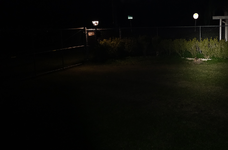I pulled 4 battery packs (2x 18650 in parallel) out of my new "commercial grade" solar post light because the light output is about 1/2 what it claims to be - so I opened it up to check for bad batteries or under-charged batteries. Battery packs are labeled as IFR-18650 3000mAh 3.2V 9.6Wh.... but I tested all 4 battery packs twice - 1 through 4 then 1 through 4 again - with my Klein mm720 multi-meter at:
1> 3.743V / 3.743V
2> 3.740V / 3.741V
3> 3.742V / 3.742V
4> 3.737V / 3.737V
So I'm thinking, they have wrong protection circuit on them, bad protection circuit, or they are regular Lithium-Ion batteries... I went back after an hour and they're still showing the exact same voltage readings, which tells me that these are very likely to be regular Lithium-Ion & NOT LiFePO4 batteries at all since all my cylindrical LiFePO4 cells drop to 3.3V in less than 1 hour after charging whether new or used. My LiFePO4 prismatic cell is a bit different as it takes hours to drop back down to 3.3V.
since all my cylindrical LiFePO4 cells drop to 3.3V in less than 1 hour after charging whether new or used. My LiFePO4 prismatic cell is a bit different as it takes hours to drop back down to 3.3V.
Putting regular lithium Ion batteries into the erratic charging cycle of a solar charging system seems like a REALLY bad idea.... Unfortunately, I cannot just open up the battery packs without voiding the 5-year warranty to see if the base batteries are labeled differently... and the company wants to charge $35 + shipping for one battery pack so not really a good option to buy a separate pack just to cut open & see if the base batteries are labeled by the original manufacturer
so not really a good option to buy a separate pack just to cut open & see if the base batteries are labeled by the original manufacturer
But once the included batteries give out (assuming they don't catch fire & burn up the light), I plan on making my own battery packs with 3000mAh 21700 LiFePO4 cells that I recently found (if they're any good...) & trying them in 2S instead of 2P for improved output.
1> 3.743V / 3.743V
2> 3.740V / 3.741V
3> 3.742V / 3.742V
4> 3.737V / 3.737V
So I'm thinking, they have wrong protection circuit on them, bad protection circuit, or they are regular Lithium-Ion batteries... I went back after an hour and they're still showing the exact same voltage readings, which tells me that these are very likely to be regular Lithium-Ion & NOT LiFePO4 batteries at all
 since all my cylindrical LiFePO4 cells drop to 3.3V in less than 1 hour after charging whether new or used. My LiFePO4 prismatic cell is a bit different as it takes hours to drop back down to 3.3V.
since all my cylindrical LiFePO4 cells drop to 3.3V in less than 1 hour after charging whether new or used. My LiFePO4 prismatic cell is a bit different as it takes hours to drop back down to 3.3V. Putting regular lithium Ion batteries into the erratic charging cycle of a solar charging system seems like a REALLY bad idea.... Unfortunately, I cannot just open up the battery packs without voiding the 5-year warranty to see if the base batteries are labeled differently... and the company wants to charge $35 + shipping for one battery pack
But once the included batteries give out (assuming they don't catch fire & burn up the light), I plan on making my own battery packs with 3000mAh 21700 LiFePO4 cells that I recently found (if they're any good...) & trying them in 2S instead of 2P for improved output.


